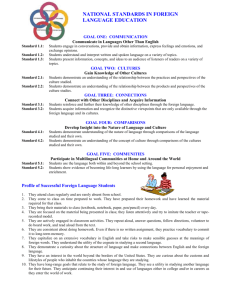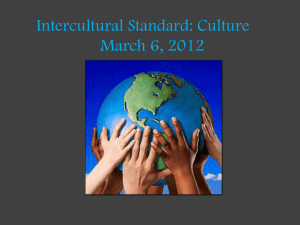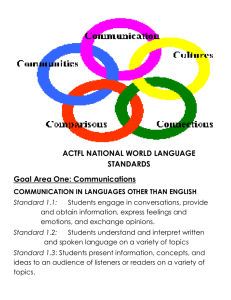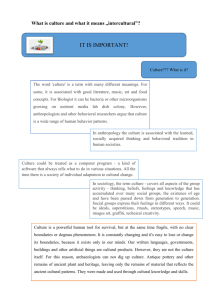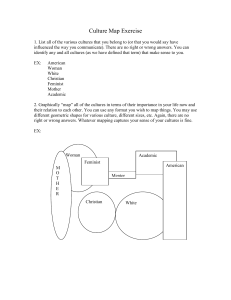Social Studies Grade Level Indicators (PS)
advertisement
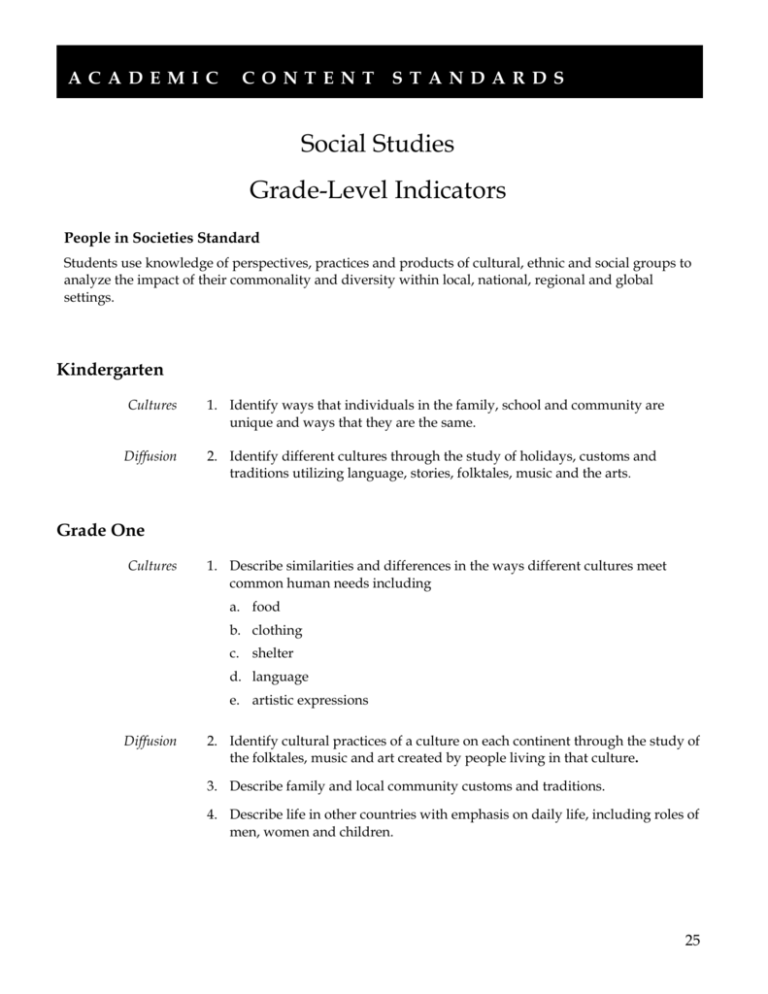
ACADEMIC CONTENT STANDARDS Social Studies Grade-Level Indicators People in Societies Standard Students use knowledge of perspectives, practices and products of cultural, ethnic and social groups to analyze the impact of their commonality and diversity within local, national, regional and global settings. Kindergarten Cultures 1. Identify ways that individuals in the family, school and community are unique and ways that they are the same. Diffusion 2. Identify different cultures through the study of holidays, customs and traditions utilizing language, stories, folktales, music and the arts. Grade One Cultures 1. Describe similarities and differences in the ways different cultures meet common human needs including a. food b. clothing c. shelter d. language e. artistic expressions Diffusion 2. Identify cultural practices of a culture on each continent through the study of the folktales, music and art created by people living in that culture. 3. Describe family and local community customs and traditions. 4. Describe life in other countries with emphasis on daily life, including roles of men, women and children. 25 ACADEMIC CONTENT STANDARDS Grade Two Cultures 1. Describe the cultural practices and products of people on different continents. Diffusion 2. Describe ways in which language, stories, folktales, music and artistic creations serve as expressions of culture and influence the behavior of people living in a particular culture. 3. Explain how contributions of different cultures within the United States have influenced our common national heritage. 4. Describe the contributions of significant individuals, including artisans, inventors, scientists, architects, explorers and political leaders to the cultural heritage of the United States. Grade Three Cultures 1. Compare some of the cultural practices and products of various groups of people who have lived in the local community including a. artistic expression b. religion c. language d. food 2. Compare the cultural practices and products of the local community with those of other communities in Ohio, the United States and countries of the world. Interaction 26 3. Describe settlement patterns of various cultural groups within the local community. ACADEMIC CONTENT STANDARDS Grade Four Cultures 1. Describe the cultural practices and products of various groups who have settled in Ohio over time a. the Paleo Indians, Archaic Indians, Woodland Indians (Adena and Hopewell) and Late Prehistoric Indians (Fort Ancient) b. historic Indians of Ohio (Ottawa, Wyandot, Mingo, Miami, Shawnee and Delaware) c. European immigrants d. Amish and Appalachian populations e. African-Americans f. Interaction recent immigrants from Africa, Asia and Latin America 2. Describe the impact of the expansion of European settlements on American Indians in Ohio. 3. Explain the reasons people came to Ohio including a. opportunities in agriculture, mining and manufacturing b. family ties c. freedom from political and religious oppression Grade Five Cultures 1. Compare the cultural practices and products of diverse groups in North America including a. artistic expressions b. religion c. language d. food e. clothing f. Interaction shelter 2. Compare life on Indian reservations today with the cultural traditions of American Indians before the reservation system. 3. Describe the experiences of African-Americans under the institution of slavery. 27 ACADEMIC CONTENT STANDARDS 4. Describe the waves of immigration to North America and the areas from which people came in each wave. 5. Compare reasons for immigration to North America with the reality immigrants experienced upon arrival. 28 ACADEMIC CONTENT STANDARDS Grade Six Cultures 1. Compare the cultural practices and products of the societies studied including a. class structure b. gender roles c. beliefs d. customs and traditions 2. Compare world religions and belief systems focusing on geographic origins, founding leaders and teachings including a. Buddhism b. Christianity c. Judaism d. Hinduism e. Islam Interaction 3. Explain factors that foster conflict or cooperation among countries a. language b. religion c. types of government d. historic relationships e. economic interests Grade Seven Cultures 1. Analyze the relationships among cultural practices, products and perspectives of early civilizations. 2. Explain how the Silk Road trade and the Crusades affected the cultures of the people involved. Diffusion 3. Give examples of contacts among different cultures that led to the changes in belief systems, art, science, technology, language or systems of government. 4. Describe the cultural and scientific legacies of African, Greek, Roman, Chinese, Arab and European civilizations. 29 ACADEMIC CONTENT STANDARDS Grade Eight Interaction 1. Trace the development of religious diversity in the colonies, and analyze how the concept of religious freedom has evolved in the United States. 2. Describe and explain the social, economic and political effects of a. stereotyping and prejudice b. racism and discrimination c. institutionalized racism and institutionalized discrimination 3. Analyze how contact between white settlers and American Indians resulted in treaties, land acquisition and Indian removal. 4. Analyze the economic, geographic, religious and political factors that contributed to a. the enslavement of Africans in North America b. resistance to slavery 5. Describe the historical limitations on participation of women in United States society and their efforts to gain equal rights. Diffusion 6. Explain how the diverse peoples of the United States developed a common national identity. Grade Nine Cultures 1. Analyze examples of how people in different cultures view events from different perspectives including a. creation of the state of Israel b. partition of India and Pakistan c. reunification of Germany d. end of apartheid in South Africa Interaction 2. Analyze the results of political, economic, and social oppression and the violation of human rights including a. the exploitation of indigenous peoples b. the Holocaust and other acts of genocide, including those that have occurred in Armenia, Rwanda, Bosnia and Iraq 30 ACADEMIC Diffusion CONTENT STANDARDS 3. Explain how advances in communication and transportation have impacted a. globalization b. cooperation and conflict c. the environment d. collective security e. popular culture f. political systems g. religion Grade Ten Cultures 1. Describe how the perspectives of cultural groups helped to create political action groups such as a. the National Association for the Advancement of Colored People (NAACP) b. National Organization for Women (NOW) c. American Indian Movement (AIM) d. United Farm Workers 2. Analyze the perspectives that are evident in African-American, American Indian and Latino art, music, literature and media and how these contributions reflect and shape culture in the United States. Interaction 3. Explain how Jim Crow laws legalized discrimination based on race. 4. Analyze the struggle for racial and gender equality and its impact on the changing status of minorities since the late 19th century. Diffusion 5. Explain the effects of immigration on society in the United States a. housing patterns b. political affiliation c. education system d. language e. labor practices f. religion 31 ACADEMIC CONTENT STANDARDS Grade Eleven Cultures 1. Choose a government policy or program and analyze how it has affected and been received by one or more racial, ethnic or religious groups a. Indian policies b. immigration laws c. segregation policies d. selective service laws Interaction 2. Identify causes of prejudice and demonstrate ways in which legal protections (including constitutional amendments and civil rights legislation) prevent and reduce discrimination. 3. Identify and analyze governmental policies that enable individuals of different cultures to participate in the United States society and economy including a. naturalization b. voting rights c. racial integration d. affirmative action Diffusion 4. Explain how the United States has been affected politically, economically and socially by its multicultural diversity (e.g., work force, new ideas and perspectives, and modifications to culture). Grade Twelve Cultures 1. Identify the perspectives of diverse cultural groups when analyzing current issues. 2. Analyze proposed solutions to current issues from the perspectives of diverse cultural groups. Interaction 3. Analyze ways countries and organizations respond to conflicts between forces of unity and forces of diversity (e.g., English only/bilingual education, theocracies/religious freedom, immigration quotas/open immigration policy, single-sex schools/coeducation). 4. Evaluate the effectiveness of international governmental organizations (e.g., United Nations, European Union, World Court and Organization of American States), multinational corporations, and nongovernmental 32 ACADEMIC CONTENT STANDARDS organizations (e.g., Amnesty International, Red Cross and World Council of Churches) in the global arena. Diffusion 5. Evaluate the role of institutions in guiding, transmitting, preserving and changing culture. 33 ACADEMIC 34 CONTENT STANDARDS


